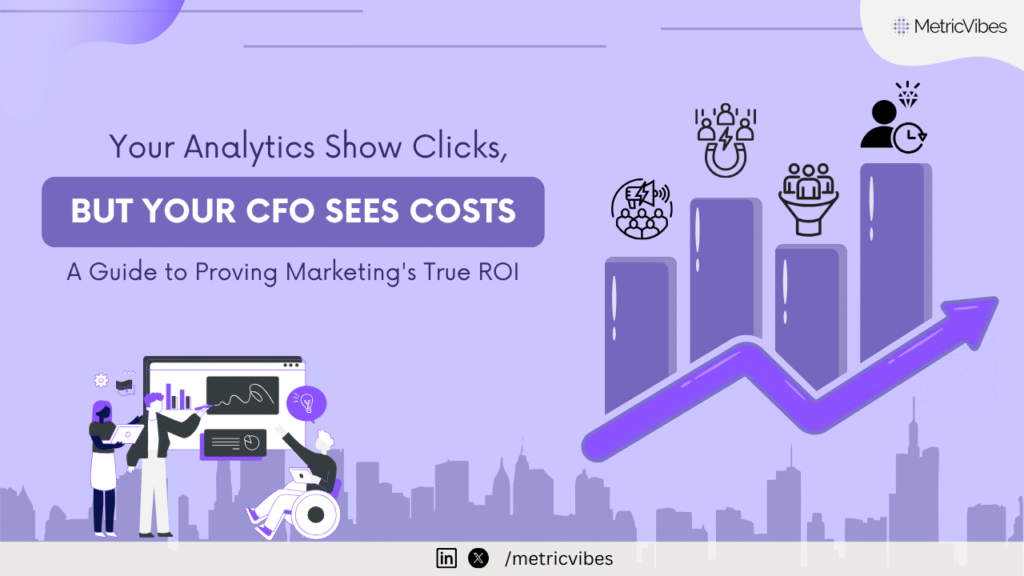Your Analytics Show Clicks, But Your CFO Sees Costs: A Guide to Proving Marketing's ROI
Beyond Clicks: The Value Staircase Framework for Proving Marketing ROI
In today’s data-saturated world, marketing leaders face a critical challenge: demonstrating the tangible value of their efforts to a financially-minded audience. While clicks and impressions offer a glimpse into activity, they rarely resonate with CFOs who prioritize bottom-line impact. Simply put, the language of clicks doesn’t translate into the language of dollars. Focus topic is Proving Marketing’s ROI
This disconnect often creates a chasm between marketing and finance, hindering investment and growth. To bridge this gap, a more sophisticated approach is needed, one that aligns marketing activities with quantifiable business outcomes. Enter the Value Staircase Framework.

The Value Staircase Framework
The Value Staircase Framework provides a structured approach to connect marketing initiatives directly to revenue generation, enabling you to demonstrate ROI in a clear and compelling way. This framework moves beyond vanity metrics and focuses on progressive stages of value creation.
Step 1: Awareness & Engagement (The Foundation)
This initial step focuses on building brand visibility and capturing audience attention. Key metrics here include reach, impressions, and engagement rates. While important, these metrics represent only the first rung on the staircase. They set the stage for future value but don’t directly contribute to revenue. Consider them as indicators of potential, not realized value.
Research suggests only half of marketers confidently track ROI, indicating a widespread need for more robust measurement strategies.
Step 2: Lead Generation (Building Momentum)
Moving up the staircase, we enter the realm of lead generation. Here, we measure the effectiveness of marketing in capturing qualified leads. Key metrics include:
- Cost per lead (CPL)
- Conversion rates
- Lead quality scores
This step demonstrates marketing’s contribution to the sales pipeline — a tangible step towards revenue generation. Optimizing CPL is crucial as acquiring new customers often surpasses the cost of retention.
Step 3: Sales Conversion (Realizing Value)
The penultimate step focuses on converting leads into paying customers. Metrics like:
- Customer acquisition cost (CAC)
- Conversion rates
- Sales cycle length are critical here.
This stage connects marketing investments to actual revenue, demonstrating the effectiveness of campaigns in driving sales. Understanding CAC is essential for efficient budget allocation and maximizing returns.
Step 4: Customer Lifetime Value (Maximizing Returns)
At the top of the Value Staircase, we find Customer Lifetime Value (CLTV). This metric represents the total revenue generated by a customer over their relationship with your business. By analyzing the CAC to LTV ratio, you can demonstrate the long-term profitability of your marketing efforts.
This holistic view resonates with CFOs, showcasing the sustained impact of marketing investment.
Bridging the Gap Between Marketing and Finance
The Value Staircase Framework empowers marketers to communicate the value of their work in a language that resonates with financial stakeholders. By focusing on the progressive stages of value creation, you can build a compelling narrative that connects marketing activities to demonstrable business outcomes.
This framework allows you to shift the conversation from clicks and impressions to revenue and ROI, ultimately enabling data-driven decisions that fuel sustainable growth.
Also check – What is marketing ROI ? – Oracle
Where Does Your Marketing Reside?
Where does your marketing currently reside on the Value Staircase, and what steps can you take to ascend to the next level?
FAQ Section
Traditional ROI calculations often focus on a single campaign. The Value Staircase Framework provides a holistic view of marketing’s contribution to revenue across all stages, from awareness to customer lifetime value.
Begin by mapping your existing marketing metrics to each step of the staircase. Then, identify the data gaps and implement tracking mechanisms to capture the necessary information. Finally, visualize the data in a clear and concise dashboard to communicate the value story to stakeholders.
Reach out for tailored analytics and personalization solutions for your business by us. Contact Here


I just like the helpful information you provide in your articles
weed products no prescription required